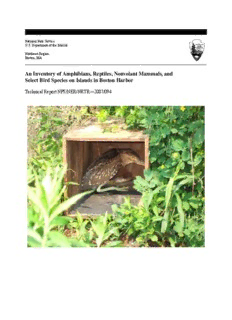
An Inventory of Amphibians, Reptiles, Nonvolant Mammals, and Select Bird Species on Islands in ... PDF
Preview An Inventory of Amphibians, Reptiles, Nonvolant Mammals, and Select Bird Species on Islands in ...
National Park Service U.S. Department of the Interior Northeast Region Boston, MA An Inventory of Amphibians, Reptiles, Nonvolant Mammals, and Select Bird Species on Islands in Boston Harbor Technical Report NPS/NER/NRTR—2007/094 ON THE COVER Juvenile Black-crowned Night Heron in a mammal box on Sarah Island Photograph by: Carol Lynn Trocki An Inventory of Amphibians, Reptiles, Nonvolant Mammals, and Select Bird Species on Islands in Boston Harbor Technical Report NPS/NER/NRTR--2007/094 Carol L. Trocki , Neil W. Talancy, and Peter W. C. Paton Department of Natural Resources Science University of Rhode Island Kingston RI 02881 August 2007 U.S. Department of the Interior National Park Service Northeast Region Boston, Massachusetts The Northeast Region of the National Park Service (NPS) comprises national parks and related areas in 13 New England and Mid-Atlantic states. The diversity of parks and their resources are reflected in their designations as national parks, seashores, historic sites, recreation areas, military parks, memorials, and rivers and trails. Biological, physical, and social science research results, natural resource inventory and monitoring data, scientific literature reviews, bibliographies, and proceedings of technical workshops and conferences related to these park units are disseminated through the NPS/NER Technical Report (NRTR) and Natural Resources Report (NRR) series. The reports are a continuation of series with previous acronyms of NPS/PHSO, NPS/MAR, NPS/BOS-RNR, and NPS/NERBOST. Individual parks may also disseminate information through their own report series. Natural Resources Reports are the designated medium for information on technologies and resource management methods; "how to" resource management papers; proceedings of resource management workshops or conferences; and natural resource program descriptions and resource action plans. Technical Reports are the designated medium for initially disseminating data and results of biological, physical, and social science research that addresses natural resource management issues; natural resource inventories and monitoring activities; scientific literature reviews; bibliographies; and peer-reviewed proceedings of technical workshops, conferences, or symposia. Mention of trade names or commercial products does not constitute endorsement or recommendation for use by the National Park Service. This report was accomplished under Cooperative Agreement 4520-99-007 with assistance from the NPS. The statements, findings, conclusions, recommendations, and data in this report are solely those of the author(s), and do not necessarily reflect the views of the U.S. Department of the Interior, National Park Service. Reports in these series are produced in limited quantities and, as long as the supply lasts, may be obtained by sending a request to the address on the back cover. When original quantities are exhausted, copies may be requested from the NPS Technical Information Center (TIC), Denver Service Center, PO Box 25287, Denver, CO 80225- 0287. A copy charge may be involved. To order from TIC, refer to document D-20. This report may also be available as a downloadable portable document format file from the Internet at http://www.nps.gov/nero/science/. Please cite this publication as: Trocki, C.L. N.W. Talancy, P.W.C. Paton. August 2007. An Inventory of Amphibians, Reptiles, Nonvolant Mammals, and Select Bird Species on Islands in Boston Harbor. Technical Report NPS/NER/NRTR-- 2007/094. National Park Service. Boston, Massachusetts. NPS D-20 August 2007 i i ii i Table of Contents Tables............................................................................................................................................vii Figures...........................................................................................................................................ix Appendixes....................................................................................................................................xi Introduction.....................................................................................................................................1 Methods..........................................................................................................................................7 2005 Pilot Study..........................................................................................................................7 Sampling Design.........................................................................................................................7 Sampling Sites............................................................................................................................7 Waterbird Monitoring 2005........................................................................................................9 Data Management.....................................................................................................................10 Data Analysis............................................................................................................................10 Results...........................................................................................................................................13 Mammal, Reptile, and Amphibian Inventory...........................................................................13 Comparison of Techniques.......................................................................................................23 Waterbird Monitoring...............................................................................................................23 Discussion.....................................................................................................................................27 Mammals...................................................................................................................................27 Amphibians...............................................................................................................................29 Reptiles.....................................................................................................................................29 Comparing Techniques.............................................................................................................30 Summary of Management Recommendations..........................................................................31 v Literature Cited.............................................................................................................................33 v i Tables Table 1. Location and ownership of 33 islands within the Boston Harbor Islands National Park Area.........................................................................................................................................3 Table 2. Survey effort, island area, and shortest distance to mainland for islands in the BOHA during 2006 (N=19; see Appendix A for coordinates of sampling stations)........................14 Table 3. Mammal, reptile, and amphibian species detected on 19 islands in the BOHA during the pilot study in 2005 and inventory conducted in 2006.....................................................15 Table 4. Summary of species richness on 19 islands in the BOHA during pilot study in 2005 and inventory in 2006; summary of species detections by station in 2006.................................16 Table 5. Summary of species detections by method on 19 islands in the BOHA during pilot study in 2005 and inventory in 2006.....................................................................................18 Table 6. Results of linear regression analyses investigating relationships between species richness and island area and distance to mainland for overall species richness (i.e., number of reptiles, amphibians, and nonvolant mammals) and mammalian species richness on islands in Boston Harbor.......................................................................................................19 Table 7. Summary of model selection procedures for occupancy (Ψ) and detection (p) probabilities for the most frequently detected mammal species on 19 islands in the BOHA, 2006.......................................................................................................................................20 Table 8. Parameter estimates for occupancy probabilities (Ψ) for raccoons, Norway rats, striped skunks, and small mammals on 19 islands in Boston Harbor based on model averaging of best models presented in Table 6. Islands in boldface = species was detected on island. Also shown are detection probabilities (p) for either model p(.) or p(session) based on best models in Table 6..................................................................................................................22 Table 9. Waterbird species detected during surveys in the BOHA.............................................24 Table 10. Estimated number of nests of waterbirds on select islands in the BOHA in 2005 (Numbers indicate total number of nests; 4-letter species codes given in Table 6).............25 vi i
Description: